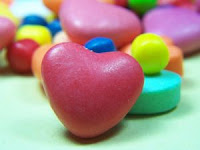“A” for business — The Sweet Underground

Children have the most wonderful ability to be kids and preserve the joys of childhood, despite adults trying their best to thwart it. :)
It’s doubtful that kids, their parents or school officials have read the 40 years of research and the findings of expert panels, such as the U.S. Preventive Services Task Force, that have found no evidence that “bad” foods cause obesity or any evidence to support healthy eating initiatives for children, but have pointed to evidence for harm. And kids don’t believe in the mythology of junk food and health food like grownups.
All kids know is what they love.
So, back in 2005 when Texas school administrators took candy out of school vending machines to create a “healthy eating environment” and replaced it with things like tuna kits, granola bars and baked chips, students turned the halls of Austin High School into Willy-Wonka-meets-Casablanca. Future business mogels opened up shop and were making $200 a week selling contraband candy to their classmates. “It's all about supply and demand,” said one student. “We've got some entrepreneurs around here.” [S]chools are even using computers to monitor each child's daily intake. Heywood Community High School in Lancashire logs what pupils choose for their dinner and a summary of their intake is included in their end-of-year report. Each pupil is identified by means of a biometric thumbprint scanner. So, kids began stocking up on sweets and snacks at neighborhood shops on their way to school and keeping their finds secret to eat “where none of them nosy teachers is looking.” Other pupils begain thriving black market businesses. Which brings us to today’s news from Canada, with equally business-savvy kids operating a brisk underground snack business in response to the school division’s tough nutrition policy that came out of the Healthy Kids, Healthy Futures task force. The Globe and Mail reports: Junk-food ban leads to black-market trade in sweets A junk food ban has spawned a black market in soft drinks and chocolate bars at a Winnipeg high school. Students at Kelvin High, chafing under a new school division policy that ended the sale of soft drinks, potato chips and chocolate in the cafeteria, have been selling the contraband items from their lockers. Locker 188 is said to be the place to go.... “I'm dealing in caffeine and sugar,” [a student making a tidy profit] said... They're part of a growing movement opposed to the new health-conscious rules, which stem from guidelines passed on to schools by the provincial government in 2005.... “They're not stopping the obesity rate in Canada by doing this.” ...A Facebook group has also sprung up, calling itself “Bring back sugar to Kelvin High School,” where students are discussing how best to organize themselves to combat the healthy-eating policy. One student wrote that the issue is no longer sugar, but freedom.... The Winnepeg Free Press just reported that these entrepreneurs are already franchising their enterprise among some of the other 77 schools in the district. Who said kids today are lazy? Since the medical research disproving the efficacy of healthy eating initiatives isn’t registering with school officials and government agencies, kids may have found their own way to make the point.  Then, last year, when food activist-celebrity chef, Jamie Oliver’s had succeeded in getting London school canteen chow revamped into “healthy foods” and the government had removed the “junkfood,” the kids boycotted the school canteen serving what they called “sick bag food.” Lunchtime found kids lined up along the school’s perimeter buying what they wanted to eat through the fence bars. The fanaticism for healthy eating in schools grew increasingly more extreme and the London Times reported that what kids could eat was being heavily policed. Mothers reported that the lunches they’d packed for their kids had been inspected, any cookies or treats removed and their children reprimanded for attempting to eat “junkfood.” As the London Times reported:
Then, last year, when food activist-celebrity chef, Jamie Oliver’s had succeeded in getting London school canteen chow revamped into “healthy foods” and the government had removed the “junkfood,” the kids boycotted the school canteen serving what they called “sick bag food.” Lunchtime found kids lined up along the school’s perimeter buying what they wanted to eat through the fence bars. The fanaticism for healthy eating in schools grew increasingly more extreme and the London Times reported that what kids could eat was being heavily policed. Mothers reported that the lunches they’d packed for their kids had been inspected, any cookies or treats removed and their children reprimanded for attempting to eat “junkfood.” As the London Times reported:




<< Home